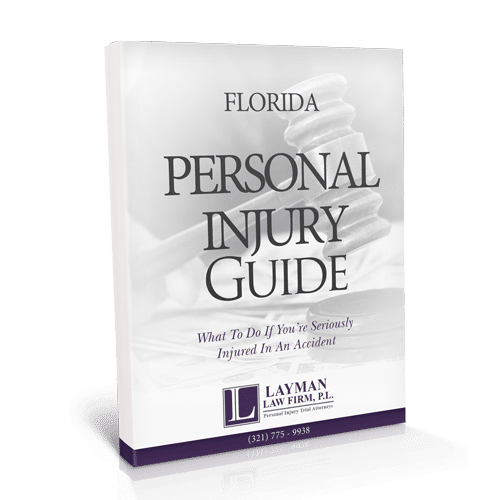Melbourne Neck and Back Injury Attorneys
Neck and back injuries can be among the most serious types of injuries sustained in a personal injury accident. While these injuries can be minor strains or sprains, they are often more severe injuries that can leave the victim with life-long pain and suffering. Neck and back injuries can also limit a victim’s ability to work or leave the victim completely unable to work, leading to financial devastation for the victim and his or her family. If you suffered a neck or back injury and another party’s negligence or wrongful conduct caused or contributed to the injury, you may be entitled to compensation for your physical and emotional injuries.
The experienced Melbourne neck and back injury attorneys at Layman Law Firm, P.L. understand how difficult it can be to try and recover physically and emotionally from a serious neck or back injury. We also know how these injuries can cause financial instability for the victim and family. Our resources, dedication, and experience can be utilized to identify the party (or parties) responsible for your neck and back injury and pursue compensation for your physical injuries and emotional trauma.
Why Are Your Neck and Back Particularly Vulnerable to Injury?
The primary reason that your neck and back are especially vulnerable to injury is that your spinal cord runs through your neck and back. According to the Cleveland Clinic, your spinal cord is “a cylindrical structure that runs through the center of your spine, from your brainstem to your low back. It’s a delicate structure that contains nerve bundles and cells that carry messages from your brain to the rest of your body. Your spinal cord is one of the main parts of your nervous system.” You also have a protective layer of bone called the vertebral column that covers and protects your spinal cord. The primary purpose of your spinal cord is to carry nerve signals throughout your body that serve three primary functions, including:
- Controlling body movements and functions
- Reporting senses to your brain
- Managing your reflexes
Your spinal cord runs from the base of your head to the bottom of your back. For the purpose of identification, your spinal cord is divided into three parts: the cervical spine (neck), the thoracic spine (chest), and the lumbar spine (lower back). Given the important nature of your spinal column, any injury to your neck or back could have serious and long-lasting consequences.
What Are Common Neck and Back Injuries?
There are about 17,810 new spinal cord injuries in the United States each year, according to the National Spinal Cord Injury Statistical Center (NSCISC). Neck and back injuries that do not directly impact the spinal cord are considerably more common. Some of the most common neck and back injuries, including those that damage the spine and those that do not, include:
- Whiplash
- Neck sprain
- Muscle strain
- Herniated disc
- Vertebral fracture
- Cervical dislocation
- Incomplete paraplegia
- Incomplete tetraplegia
- Complete paraplegia
- Complete tetraplegia
How Do Neck and Back Injuries Happen?
Given that your neck and back are used when you do just about everything from running to simply sitting and watching the television, it should come as no surprise that you can be injured in a wide variety of ways. According to the NSCSC, however, motor vehicle accidents are the leading cause of spinal cord injuries. Other common causes of neck and back injuries include:
- Falls
- Acts of violence (primarily gunshot wounds)
- Workplace accidents
- Sports and recreation accidents
- Medical and surgical errors
How Are Neck and Back Injuries Treated?
If the spinal cord is partially or totally severed because of a neck or back injury, the severity of the injury may be immediately apparent. All too often, however, determining the extent of a neck or back injury requires diagnostic imaging and evaluation by a health care professional. X-Rays, a CT Scan, and/or an MRI may be ordered to determine what type of injury you suffered and the severity of the injury. The type, length, and cost of treatment for a neck or back injury will depend on how serious the injury is but may include things such as:
- Medications to reduce inflammation
- Injections
- Traction
- Immobilization
- Physical therapy
- Surgery to replace a disc or repair a fracture
In addition, if the injury causes permanent paralysis, a victim will need specialized equipment, modifications to his/her home, and lifetime medical care as a result of the paralysis. The delicate and complex nature of the human spinal column means that even injuries that do not result in paralysis can cause permanent nerve damage, stenosis, and arthritis within the neck and back, which will also prompt the need for lifetime treatment.
Am I Entitled to Compensation for My Melbourne Neck or Back Injury?
According to the Christopher and Dana Reeves Foundation, the average lifetime cost for a 25-year-old who suffers a spinal cord injury is between $1.7 million and $5.2 million, depending on the type and severity of the injury. Even a less serious neck or back injury can be expensive to treat and prevent the victim from earning the same income he/she earned prior to the injury. If you suffered a neck or back injury that was caused, in whole or in part, by another party, you might be entitled to compensation for your injuries.
When negligence or wrongful conduct contributed to a neck or back injury, the victim may be entitled to compensation for the economic and non-economic damages suffered because of that negligence or wrongful conduct. A motorist who was texting while driving and caused a collision is a common example of negligence. Wrongful conduct that might lead to liability includes things such as intentional assault or contributing to a defective product reaching the stream of commerce.
Economic damages are intended to compensate a victim for objective, easily proven, damages, including things such as:
- Medical expenses, including doctor, hospital, and therapist expenses
- Rehabilitation, in-home care, and long-term care costs
- Lost income or loss of earning capacity
- Specialized medical equipment
Non-economic damages compensate an injured victim for the subjective damages caused by the defendant’s negligence, such as:
- Pain and suffering
- Emotional distress
- Loss of enjoyment of life
- Disfigurement
- Mental anguish
- Loss of consortium
Contact the Experienced Melbourne Neck and Back Injury Attorneys at Layman Law Firm, P.L.
If you suffered a neck or back injury that you believe was caused by the negligent or wrongful conduct of another party (or parties), contact the experienced and compassionate Melbourne neck and back injury attorneys at Layman Law Firm, P.L. to discuss your legal options. Contact the team today for your free initial consultation by calling 321-773-2111 or by filling out our convenient Intake Evaluation Form online.






